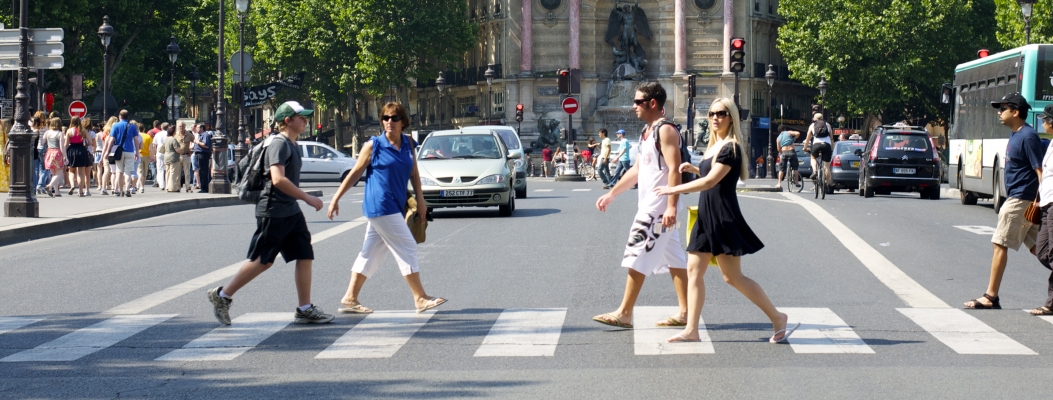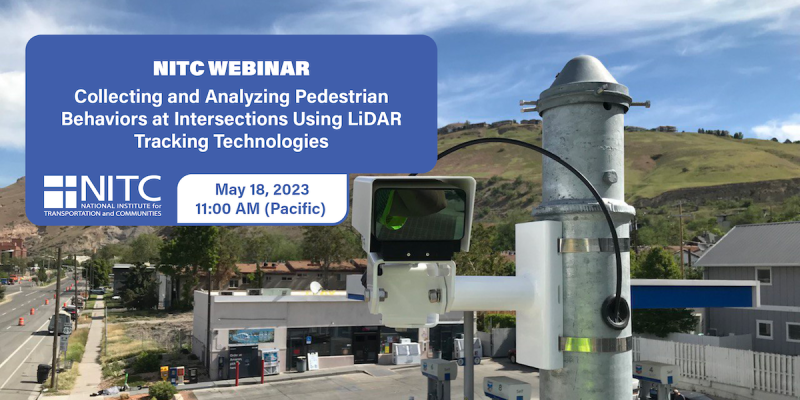This OTREC educational project took students at Portland State University beyond the lecture hall and the library. Dr. Lynn Weigand expanded the bicycle and pedestrian design curriculum at PSU by turning an existing three-credit course into a five-credit course with an applied lab. The new course gave students the opportunity to apply the knowledge they gained in class to real projects in their community. Working in teams, the students developed projects that focused on improving bicycle and pedestrian connections to the PSU campus. The course received excellent reviews from the students, and the department recognized the courseís value by offering it again the following year. The report can be downloaded at: https://ppms.trec.pdx.edu/media/project_files/OTREC-ED-10-01.pdf.
Professor John Pucher, a car-less commuter from the Bloustein School of Planning and Public Policy at Rutgers University, was the first fall OTREC Visiting Scholar and CTS Seminar guest on September 28, 2007. His presentation, "Promoting Safe Walking and Cycling to Improve Public Health: Lessons from Europe," was standing room only, and the audience enjoyed his photos of bike-friendly features in cities across Europe. Pucher examined a range of public health impacts of our urban transport systems and argued that the current car dependence of American cities is responsible for enormous environmental harm, social isolation, lack of physical activity, and traffic dangers. He described how improving the convenience, safety, and attractiveness of walking and cycling in crucial to overcoming these negative impacts. Pucher discussed specific policies and programs used in Europe, and advocates their widespread adoption in American cities. A lively discussion with faculty, students and members of the Portland Bicycle Master Plan Committee followed the seminar.
The video begins at 0:49.
It has been nearly 25 years since non-motorized modes and non-motorized-specific built environment measures were first included in the regional travel demand models of metropolitan planning organizations (MPOs). Such modeling practices have evolved considerably as data collection and analysis methods improve, decisions-makers demand more policy-responsive tools, and walking and cycling grow in popularity. Many models now explicitly consider the unique characteristics of walking travel, separate from travel by bicycle. As MPOs look to enhance their models’ representations of pedestrian travel, the need to understand current and emerging practice is great.
This project presents a comprehensive review of the practice of representing walking in MPO travel models. A review of model documentation determined that – as of mid-2012 – 63% (30) of the 48 largest MPOs included non-motorized travel in their regional models, while 47% (14) of those also distinguished between walk and bicycle modes. The modeling frameworks, model structures, and variables used for pedestrian and non-motorized regional modeling are described and discussed. A survey of MPO staff members revealed barriers to modeling non-motorized travel, including insufficient travel survey records, but also innovations being implemented, including smaller zones and non-motorized network assignment. Finally, best practices in...
Read moreWatch video
View slides
There is growing support for improvements to the quality of the walking environment, including more investments to promote pedestrian travel. Planners, engineers, and others seek improved tools to estimate pedestrian demand that are sensitive to environmental and demographic factors at the appropriate scale in order to aid policy-relevant issues like air quality, public health, and smart allocation of infrastructure and other resources. Further, in the travel demand forecasting realm, tools of this kind are difficult to implement due to the use of spatial scales of analysis that are oriented towards motorized modes, vast data requirements, and computer processing limitations.
To address these issues, a two-phase project between Portland State University and Oregon Metro is underway to develop a robust pedestrian planning method for use in regional travel demand models. The first phase, completed in 2013, utilizes a tool that predicts the number of walking trips generated with spatial acuity, based on a new measure of the pedestrian environment and a micro-level unit of analysis. Currently, phase two is building upon this tool to predict the distribution of walking trips, connecting the origins predicted in phase one to destinations. This...
View the presentation slides here.
This project builds on the success of NITC’s first Pooled Fund project that created the first national...
Read moreThe video begins at 4:13.
Wei Feng: Impacts of Economic, Technological and Operational Factors on the Economic Competitiveness of Electric Commercial Vehicles in Fleet Replacement Decisions
Electric commercial vehicles (ECV) have the potential to substantially reduce greenhouse gas emissions, noise, and pollution in urban areas. In addition, ECVs have lower per-mile operating costs and potentially lower maintenance costs. However, the initial purchase cost of ECVs is significantly higher than the purchase cost of a conventional diesel vehicle. From a purely economic perspective, there is a cost tradeoff between the low operating and maintenance costs of ECVs and their high initial capital costs. In this paper, a fleet replacement optimization framework is employed to analyze the competitiveness of ECVs. Scenarios with different fleet utilization, fuel efficiency and sensitivity analysis of ten additional factors indicate that ECVs are more cost effective when conventional diesel vehicles’ fuel efficiency is low (8.2 miles/gallon) and daily utilization is more than 54 miles. Breakeven values of some key economic and technological factors that separate the competitiveness between ECVs and conventional diesel vehicles are calculated in all scenarios. For example, in low conventional diesel vehicle fuel efficiency and low daily utilization scenario, ECVs are more competitive when their purchase prices...
Read morePRESENTATION ARCHIVE
OVERVIEW
The aim of this research is to investigate pedestrian behavior at signalized intersections using state-of-the-art LIDAR sensing technologies and to use this data, along with vehicular data, to develop a more effective multimodal signal control system.
In the presentation, the presenters will describe a novel method of collecting pedestrian crossing behaviors at signalized intersection, discuss the findings and implications of data analytics, and introduce a novel approach to dynamic flashing yellow arrow mechanisms to reduce the conflict between left turn vehicles and crossing pedestrians.
KEY LEARNING OUTCOMES
- Understand the framework of LiDAR sensing solutions;
- Understand how to collect pedestrian behaviors at intersections;
- Understand how to provide new protection for crossing pedestrians with object-tracking technologies.
THE RESEARCH
This webinar is based on a study funded by the National Institute...
Read more

